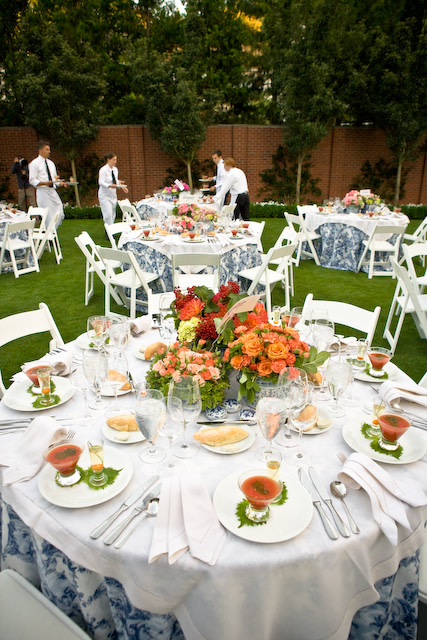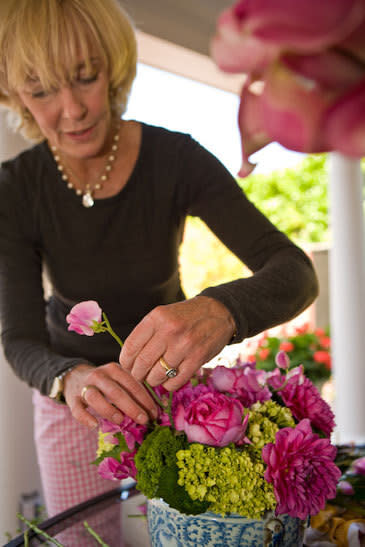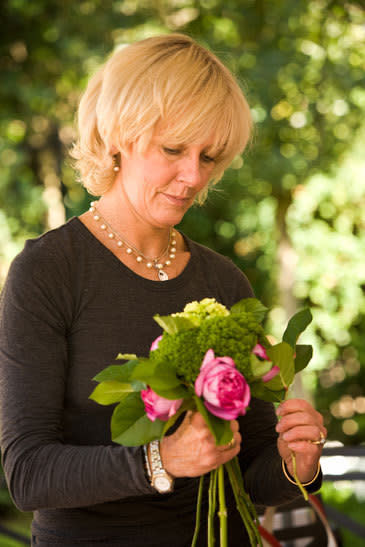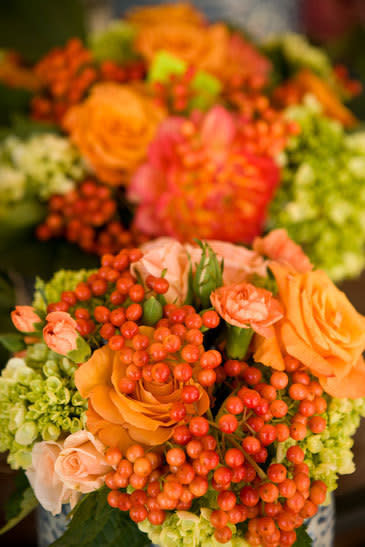Center of Attention

Whether you’re throwing a party for two or twenty, a centerpiece for the table immediately elevates the setting from ordinary to elegant. They can range from groupings of items like candlesticks and glassware, to natural objects like greenery, twigs or rocks. But traditionalists fall back to what’s simple and always in style: beautiful floral centerpieces. When done right, they can be modern and funky, setting the mood of the entire affair.
Portland floral designer Kathy Kelly designed the centerpieces for interior designer Julie Stott’s outdoor summer garden party. She created impressive and substantial arrangements using Stott’s collection of 19th-century Japanese Amari ceramics. Here are some of Kelly’s expert tips to guide you through creating professional-looking arrangements.
{page break}

Pick your vessel
To begin, pick your container. Kelly was lucky to have a ready-made collection of beautiful Amari ceramics, so she based everything off their size and blue-and-white color palette. Try using your own vintage ceramics or pottery—you can show off your floral arranging skills and your collections at the same time. Or, for a less-expensive (and easier to find) solution, use glass, terra cotta or wood vessels. Kelly shops at Bedford Brown (1825 NW Vaughn St), CostPlus World Market (multiple locations, worldmarket.com) and Cargo (380 NW 13th Ave) to find unique containers from around the world. Keep your material consistent, but vary the sizes for added texture and visual interest.
Choose your flowers
When choosing the best blooms, consider three things: the season, the color palette of the surroundings, and the scale of the room and vessels. Kelly created her centerpieces in the summer at the peak of dahlia season, so she included a mix of dahlias, roses, hydrangeas and viburnum. For fall or winter centerpieces, Kelly recommends conifers, branches, foliage, berries and winter bulbs.
The setting at Stott’s party was basically a large green expanse of lawn. To counteract the unbroken neutral color—and because the Amari pieces were fairly large—Kelly created hefty, dense centerpieces, punched with saturated pink and peach flowers. “Try to find flowers that have different blooms, like roses and dahlias, but are in the same tones,” Kelly says. “Mix textures with similar colors.” Neutral greenery, including hydrangeas, geranium leaves, ferns and hostas, balance the color and add volume. Scale is key: use blooms that fit your vessels and when finished, create an arrangement that also fits the size of the room.
{page break}

Sculpt the arrangement
Now that you’ve chosen the perfect marriage of containers and blooms, it’s time to start arranging. First, add water to your vessels. Kelly recommends including a teaspoon of bleach, plus a splash of sugary soft drink (like Sprite) per one gallon of regular tap water. The bleach cleanses the water; the sugar water makes the plants last longer. However, don’t use regular table sugar, it can clog the stems.
Begin arranging the flowers in your hand, holding the stems just below the blooms. Start with your greenery, adding colored blooms as needed. When satisfied with your initial arrangement (you’ll add more later), wrap a rubber band around the stems. Next, determine the best height of the arrangement. Remember, centerpieces should be situated so your guests can see and talk to each other from across the table. “The flowers should be enjoyed, but they should be part of the background,” Kelly says. To be sure the arrangements are not too tall, place your elbow on the table, extending the lower part of your arm vertically. Do not let the blooms go higher than your fingertips. (If you use twigs that can be seen through, they can extend higher than denser blooms.) Place your initial stems in the container to determine the correct height, then remove them and snip the ends at an angle. (Cut them under water if you have a bucket at hand.)
After your first stems are cut to fit, place them back in the container and snip the rubber band. This allows the blooms to fall into place organically. Fill out the remaining arrangement by adding more greenery and blooms, keeping in mind some of the basic principles of any piece of art: line, shape, space, value, color and texture. The arrangement shouldn’t overpower your container. You can create a striking, modern display with just a few blooms in multiple vases. “To a large degree, flower arranging is very intuitive,” Kelly says. “I tend to gloss over the rules; it’s more fun that way.”
{page break}

Set the table
If your room allows it, don’t shy from creating a fairly large grouping at the center of the table. Play with different widths and heights of containers—the end result will look like one large container, but the space created in between the vessels allows them to breathe, adding depth and dimension. You can also keep your creations looking beautiful for some time after your party by giving your flowers a fresh cut and clean water (including the bleach and sugar water) every few days.
Choose for the Season
Floral designer Kathy Kelly used summer blooms like dahlias, roses, and hydrangeas for Julie Stott’s centerpieces. But if you are throwing a fall or winter bash, here are some of her recommendations: Try arrangements of conifers; branches with red and yellow pops of color; foliage like magnolias, eucalyptuses and bay; berries like Hawthorne, viburnum, ilex, and bittersweet; or winter bulbs like paper whites, amaryllis, and hyacinth. Kelly also recommends combining roses and carnations in the winter—although not the most beautiful bloom, carnations come in a large array of colors. When grouped with similar-colored roses, it’s a pleasant mix of texture. Kelly also recommends alstameria, which lasts a long time, comes in a variety of colors and is relatively inexpensive. Orchid blossoms, although more expensive, pair very well with winter arrangements, and last almost twice as long as cut flowers. Kelly buys her blooms at the Portland Flower Market, however, they sell to the trade only. So Kelly recommends Trader Joe’s (multiple locations, traderjoes.com), Costco (multiple locations, costco.com) and your local farmers’ markets to pick up high-quality, inexpensive blooms.
